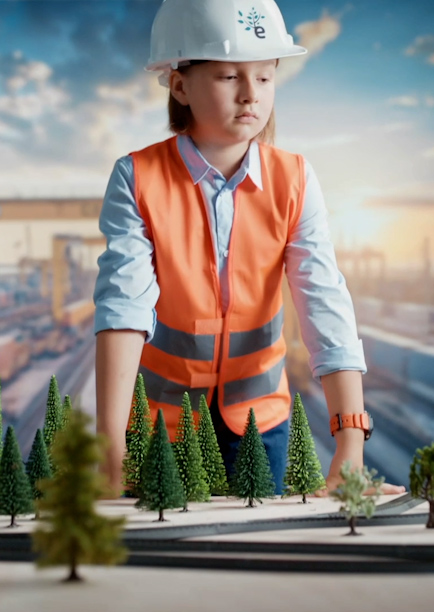Delivering Resilient Infrastructure
Through Virtual Twins
Kids shouldn’t have to worry about growing old – but they might need be concerned about the built environment that surrounds them. That’s because infrastructure right across the world today is aging or otherwise inadequate for society’s needs.
In the US, many water lines were installed more than 75 years ago. In the UK, nearly 1,100 renewable energy projects¹ are awaiting connection to a grid that has not kept pace with generating capacity. In France, outdated rail networks are falling short of national mobility needs².
Simply put, global infrastructure needs an upgrade – whether that means maintaining old infrastructure or delivering new projects. However, this comes with a cost, and current studies project a $15 trillion gap between global infrastructure needs and spending through to 2030³.
Investment is sorely needed – but many investors are put off by the risk and complexity of infrastructure projects. The question is: can digital technology help de-risk these projects, and help make the financial case for infrastructure delivery?
Capital project expenditure and delay by sector
Expenditure and delay by sector
Bringing Infrastructure Project Development into the Digital Age
With large numbers of stakeholders, multifaceted supply chains, specialized labor demands, and a long ROI horizon, infrastructure projects can be difficult to get off the ground.
“Currently, research estimates that 50 to 70% of government transportation infrastructure budgets are spent on maintaining or replacing aging infrastructure⁴ ,” says Audrey Goulven, Sustainable Infrastructure and Clean Energy Director, Dassault Systèmes. “And the private sector may be hesitant to commit capital to new projects if governments are not able to create investment-ready project pipelines.”
Could digital technology make the difference? Infrastructure has been described in the past, by the World Economic Forum, as 'the least digitally transformed sector in the entire global economy'⁵. Progress, though, is being made, and the more technology can deliver value through defining project KPIs, identifying risks and opportunities, assessing mitigation measures, and clarifying management processes, the more it will be embraced.
Virtual twins can play a key role in leading industry digitalization. “A collaborative platform allows you to consolidate all project data in a single environment, align all stakeholder groups around consistent goals and ROI targets, manage all the interests at stake, and communicate strategy clearly throughout your network,” says Goulven.
And the opportunities are great. When it comes to digital infrastructure projects, research suggests that every dollar invested in a virtual twin can mean nine dollars written off the investment. They can even reduce design costs by as much as 50% and cut permitting time in half.⁶
Getting Infrastructure Development Projects off the Ground
Large-scale infrastructure projects require huge levels of coordination and collaboration. The Grand Paris Express is currently one of the biggest infrastructure projects in the world: an ambitious, multi-billion-dollar extension of the Parisian subway network, with around 100 separate worksites, employing a workforce of more than 7,000 people.
Such complexity brings with it significant risk, from unexpected disruptions to time overruns and safety issues. But by leveraging virtual twins, it is possible to keep track of these scenarios, streamlining and de-risking projects.
Italian engineering firm IDeCOM, for example, used the 3DEXPERIENCE® platform to assist in the development of a new railway station. “When construction started, the site conditions were challenging, so we proposed integrated models which pulled together data from different design firms,” says Alessandro Pedretti, Senior Engineer, IDeCOM. “Before, there was a problem with integration, but we managed it all successfully through the platform.”
Maintaining and Operating Future-Ready Infrastructure
Another challenge around delivering future-ready services comes down to infrastructure asset management and maintenance. However, virtual twins can digitize product and process information and make it accessible to maintenance crews working decades after the original stakeholder teams have moved on. Such uses can help define the future of a project by assisting with infrastructure lifecycle management.
For instance, Japanese civil engineers Pacific Consultants are using virtual twins to digitize in-house expertise. “We are trying to accumulate the wisdom of the company’s skilled professionals within Pacific Consultants so that it isn’t lost,” says Hisaya Fujii, Senior Executive Officer, Director and Head of Osaka Headquarters, Pacific Consultants.
It can even help deliver enhanced management capabilities. “AI can be integrated into asset twins to enable predictive maintenance, or run virtual experience around specific parameters, like noise or dust spread,” says Goulven. “This can add detail to your picture of the project and enable owners to make informed decisions and have targeted conversations with specific stakeholders.”
Virtual twins can digitize product and process information, making it accessible to maintenance crews working decades later.
By providing a bird’s-eye view of complex infrastructure projects and assets, virtual twins can help stakeholders see and share key data at every stage of the project lifecycle, limiting risk and unnecessary expenditure, while planning for long-term management and maintenance.
Meet Tomorrow’s Infrastructure Innovators
But delivering the resilient infrastructure of tomorrow relies on having a whole new generation of skillsets, from industrial engineers to BIM modelers. Yet, according to experts, these skills have yet to materialize. Dassault Systèmes is empowering academic institutions to provide Education Experiences that help to address this shortage and transform engineering education to ensure that graduates are not just task-ready, but industry-ready.
Don't miss Amy on Disruptors Unleashed!
In this podcast episode, Thierry Chevrot, 3DEXPERIENCE Edu lead at Dassault Systèmes, and 9-year-old Infrastructor Amy explore how we can bring industry into the classroom and transform students of today into the next generation of sustainable innovators.


Insights on Resilient and Sustainable Infrastructure
The Infrastructure Resilience Framework is a structured approach to enhance the ability of infrastructure systems to withstand, adapt to, and recover from disruptions. It involves assessing risks, improving system robustness, and incorporating adaptive measures to ensure continued functionality during and after adverse events.
The principles of resilient infrastructure include:
Robustness: Designing and constructing infrastructure to withstand extreme events and minimize damage.
Redundancy: Incorporating backup systems and alternative pathways to ensure functionality if primary systems fail.
Resourcefulness: Efficiently managing resources during disruptions, including mobilizing materials and personnel quickly.
Adaptability: Modifying and evolving infrastructure in response to new threats and changing conditions.
Integration: Coordinating across various sectors and systems to ensure comprehensive and cohesive responses to disruptions.
Sustainability: Building infrastructure that supports long-term environmental, social, and economic goals while maintaining resilience.
Resilience in critical infrastructure refers to the ability of systems and networks to anticipate, withstand, adapt to, and recover from disruptions or failures. It involves ensuring that essential services remain functional and can quickly return to normal operations after incidents such as natural disasters, cyber-attacks, or system malfunctions.
Examples of resilient infrastructure include flood-resistant buildings with elevated foundations, earthquake-resistant bridges designed to flex and absorb seismic forces, and power grids with redundant pathways and backup systems to maintain service during outages. These infrastructures are engineered to withstand and quickly recover from extreme events, ensuring continuity of essential services.
Sustainable Development Goal 9 focuses on building resilient infrastructure, promoting sustainable industrialization, and fostering innovation. The link between this goal and resilient infrastructure lies in the aim to develop infrastructure that can withstand and adapt to challenges, thereby supporting economic growth and sustainability while mitigating the impacts of disruptions.
Digital technologies — such as virtual twins, data analytics, and AI — play a key role in strengthening the security and resilience of critical infrastructure. By consolidating data in a single collaborative environment, virtual twins give stakeholders a real-time, bird’s-eye view of complex systems. This enables early identification of vulnerabilities, simulation of disruptive scenarios like extreme weather events or cyberattacks, and the design of effective mitigation strategies.
AI-driven predictive maintenance helps anticipate failures before they happen, while digital models support rapid response and recovery when incidents occur. Together, these capabilities ensure that essential infrastructure systems remain secure, reliable, and adaptable in the face of evolving threats and disruptions. capabilities ensure that essential infrastructure systems remain secure, reliable, and adaptable in the face of evolving threats and disruptions.



